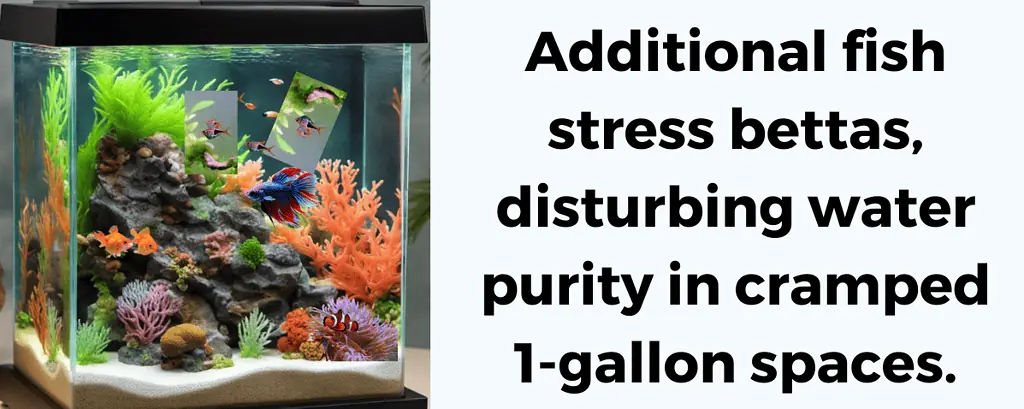Caring for a betta fish in a mere 1-gallon tank? Think again.
While it may seem manageable, this small space can lead to troubles lurking beneath the surface.
In such tight quarters, the water quality deteriorates rapidly. This strains the betta, making it an easy target for diseases.
Imagine yourself in a cramped room, barely enough to move. That’s how your betta feels.
This confinement can trigger behavioral issues and harm the fish’s overall health.
That’s why experts suggest a roomier home—a tank of at least 5 gallons. This gives your betta fish the space it needs to flourish and feel free.
Key Takeaways
- Keeping a betta fish in a 1-gallon tank is possible but not ideal for its well-being.
- A small tank can cause water quality issues, stress, and increased vulnerability to diseases in betta fish.
- Opt for a larger 5+ gallon tank to provide a suitable environment for betta fish to thrive and grow.

Table of Contents
Betta In A 1-Gallon Tank: Why It’s Not Ideal

Downsides of a 1-Gallon Tank
You might be thinking, “It’s just a small fish. Why would it need a vast tank?”
While bettas can live in a 1-gallon of water, it’s far from their dream home, especially when compared to larger aquariums.
Here’s why:
Restricted Swim Space
Bettas, like us, enjoy a good stretch now and then. Being tropical by nature, they crave room to glide and roam.
A 1-gallon space, unfortunately, is like placing them in a cramped space.
It doesn’t just cramp their style; it stresses them out.
Plus, they don’t get to interact with potential tank mates like shrimp or snails.
Unstable Waters Ahead
The lesser water, the harder it is to keep the water clean and have a cozy environment.
In a tiny tank, temperatures can fluctuate wildly, and waste builds up faster than you can say, “Fish on the move!”
What does this mean for your betta? It’s like riding a roller coaster – but not the fun kind.
Opt For A Roomier Tank

For a happier, healthier betta, aim for a tank that’s a minimum of 5 gallons in size.
It’s like upgrading them from a sleeping bag to a comfy king-sized bed.
Trust us; your betta will thank you with vibrant colors and energetic flips. 🐟
Maintenance Struggles Galore

Sure, a 1-gallon tank might seem convenient and space-saving, but it comes with its fair share of woes when considering the minimum size for tanks for betta fish.
Let’s dive into these choppy waters:
Frequent Water Changes
With limited water to dilute waste, the small tank rapidly becomes a hub for unwanted ammonia.
This means you’re on constant water-changing duty, almost every other day, to fend off that pesky ammonia build-up.
Your betta? They’re hoping for cleaner waters without you having to be on 24/7 surveillance.
The Temperature Tango

Bettas love to bask in water temperatures between a snug 78-80°F.
But with a tiny tank? It’s like dancing on a seesaw.
The temperature swings are wild and frequent.
And for a betta, these fluctuations are more frustrating than fun.
Space: The Final Frontier
Imagine squeezing a king-sized bed, a wardrobe, and a desk into a tiny closet.
That’s what it feels like when you’re trying to fit essential equipment (think filters, heaters, and live plants) into a cramped tank.
Bettas don’t just crave swimming space; they yearn for cozy corners to retreat to and feel secure.
Housing Conditions for Betta Fish

Temperature Requirement
Temperature isn’t just a number; it’s a lifeline for your Betta fish.
Ideally, keep the water between 78 to 80°F.
Too cold of a temperature stresses your Betta and might even welcome diseases.
So, always have an eye on that thermometer. Your fish’s well-being hinges on it.
Water Parameters

Your Betta’s health is also balanced when discussing freshwater parameters. Here’s the deal: ammonia, nitrite, and nitrate levels can be sneaky threats.
Especially in a 1-gallon tank, these levels can sway too quickly, potentially harming your fish.
Regular checks? Non-negotiable.
And here’s a pro tip: opt for a larger, 5-gallon tank. It offers more stability and less hassle with water changes.
Ideal pH Level
The pH level? Your Betta votes for neutrality. Aim for around 7.0.
If you notice any shifts, don’t hesitate to step in. Using filtration, water conditioners, or buffers keeps things in check.
Decorations and Hiding Spots

Think of your Betta as an explorer—a tiny adventurer who loves nosing around.
So, jazz up their tank! Add plants, rocks, or other decor.
It’s not just about aesthetics; it’s about offering them a playground and a comforting hideaway.
Substrate and Sand
The base of your tank, whether sand or gravel, can set the mood for your Betta.
But a word of caution: steer clear of sharp-edged substrates.
Your Betta’s fins are elegant but fragile.
Your Betta fish’s tank isn’t just water and walls. It’s a world. Build it with care, diligence, and a sprinkle of creativity, and you’ll see your finned friend flourish.
Health Concerns for Betta Fish in 1-Gallon Tanks

Common Diseases
In smaller tanks like the 1-gallon, rapid water condition changes can spell trouble for your betta. Watch out for:
- Fin rot: Bacteria thrive in poor water. They prey on your betta, gnawing away at its majestic fins.
- Ich: White spots on your betta? That’s Ich. Deadly if ignored, this parasite demands immediate attention.
- Ammonia poisoning: Small tanks build up ammonia quickly. Excess ammonia scorches the gills, leading your fish to a tragic end.
To fend off these threats? Monitor water conditions, change them often, and jump on any disease signs immediately.
Stress Indicators
In the confines of a 1-gallon tank, your betta feels the squeeze, weakening its defenses against disease. Stress signals?
- Sluggish moves or sheer inactivity
- Shunning food like it’s gone out of style
- Panting or strained breaths
- Wild, unpredictable swims
The solution? Think bigger tanks, pristine waters, and secret hideaways to give your betta some “me-time.”
Quality of Life
Sure, bettas can squeeze into tight spots. But a 1-gallon? That’s pushing it. Want a thriving betta? Here’s how:
- Upgrade: Betta’s digs should start at 5 gallons. The more room, the merrier the swim.
- Decorate: Plants and trinkets do more than beautify. They’re your betta’s private nooks, cutting down stress.
- Essentials: A filter and heater keep the waters just right. In tiny tanks, temps can swing and dirty up fast. The duo ensures betta bliss.
Choosing the Right Tank Size for Betta Fish

5-Gallon Tank: A Superior Choice
Sure, you can keep a betta in a 1-gallon tank. But would you want to live in a closet? A 5-gallon tank like this one is your betta’s sweet spot. Here’s why.
Ample Room to Roam
Bettas are like the explorers of the fish world. They’re curious and love a good swim-about.
In a measly 1-gallon setup, your betta’s essentially pacing back and forth in a tiny room. But with 5 gallons? It’s like a personal playground.
They get to move, dance, and show off those beautiful fins, all while keeping stress at bay. It leads to a healthier, peppier betta.
Consistent, Safer Waters

Imagine living in a room where the temperature jumps up and down, and you can’t predict if it will be too hot or too cold next.
Doesn’t sound pleasant. Small tanks can’t keep steady water conditions. They’re unpredictable – a betta’s nightmare.
But with a 5-gallon tank, the water’s temperament stays even.
You get a stable ecosystem. Beneficial bacteria have space to thrive, ensuring a steady nitrogen cycle and crystal-clear waters.
So, not only is your betta swimming in style but also in safety.
Frequently Asked Questions

What is the ideal tank size for betta fish?
Betta fish thrive in spaces that allow them to swim freely. While they can survive in pint-sized tanks, a 5-gallon tank (or larger) sets the stage for their best life.
This space ensures room to roam and is spacious enough for essential equipment like filters and heaters. Bottom line? The more room, the happier and healthier your betta.
How does tank size influence betta fish health?
Ever feel claustrophobic in a cramped elevator? Betta fish feel the same in tight spaces. A tank the size of a 1-gallon jug can spell trouble. It:
* Limits their swim territory, ramping up stress and health woes.
* Lets water quality nosedive, making bettas prone to diseases.
* Can’t fit the gear—a filter, a heater—that bettas need for peak health.
So, sizing up isn’t just about luxury; it’s a health move.
How do I keep a small betta fish tank in tip-top shape?
If you’re working with a space as small as a 1-gallon tank—though we don’t recommend it—here’s how to make the most of it:
Swap the water often. Tight spaces dirty up fast. Stay ahead with regular water changes.
Keep tabs on water vitals. Track temperature, pH, and ammonia. Aim to keep conditions betta-friendly.
Warm things up. Bettas like it cozy—between 78° and 80°F. A heater can help hit that sweet spot.
Toss in some hideaways. Plants and caves cut down on betta stress. It’s like giving them a little retreat.
Say no to roommates. Even if they’re tiny, other creatures can stress out your betta and mess with water purity.
In a nutshell, bigger tanks are a win for bettas. But if you’re set on a smaller setup, follow the above tips. Your betta’s health—and those vibrant colors—will thank you.


